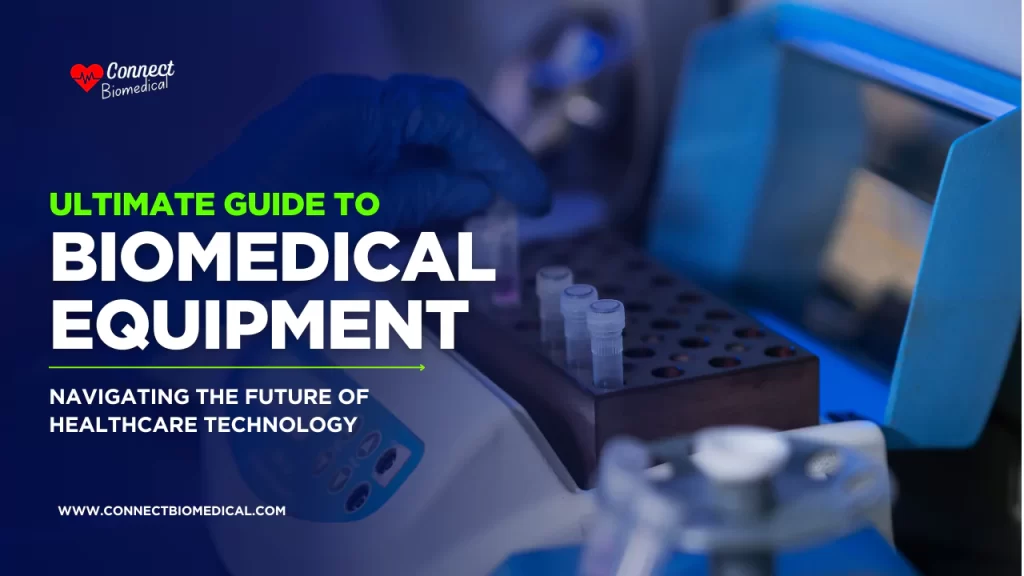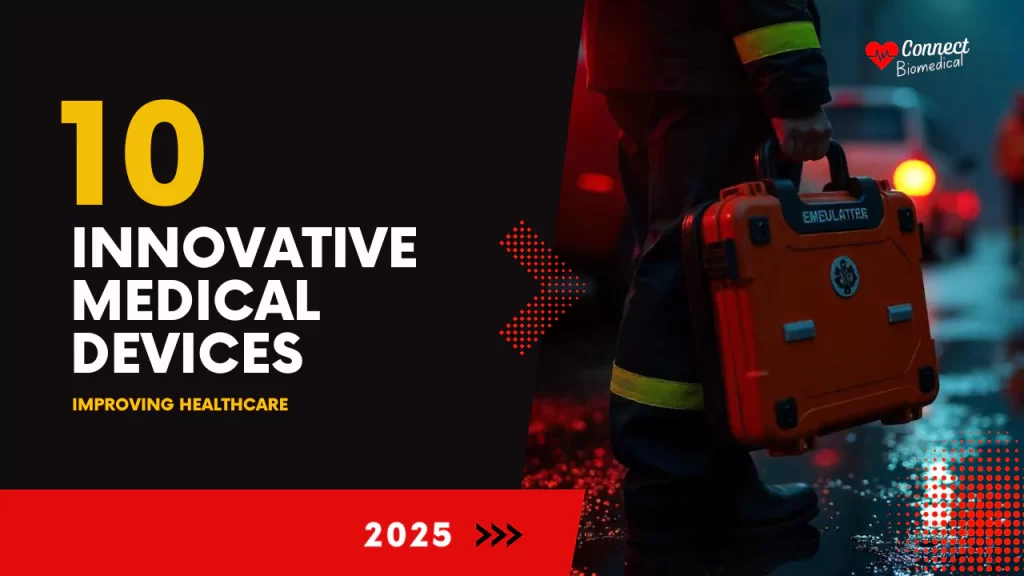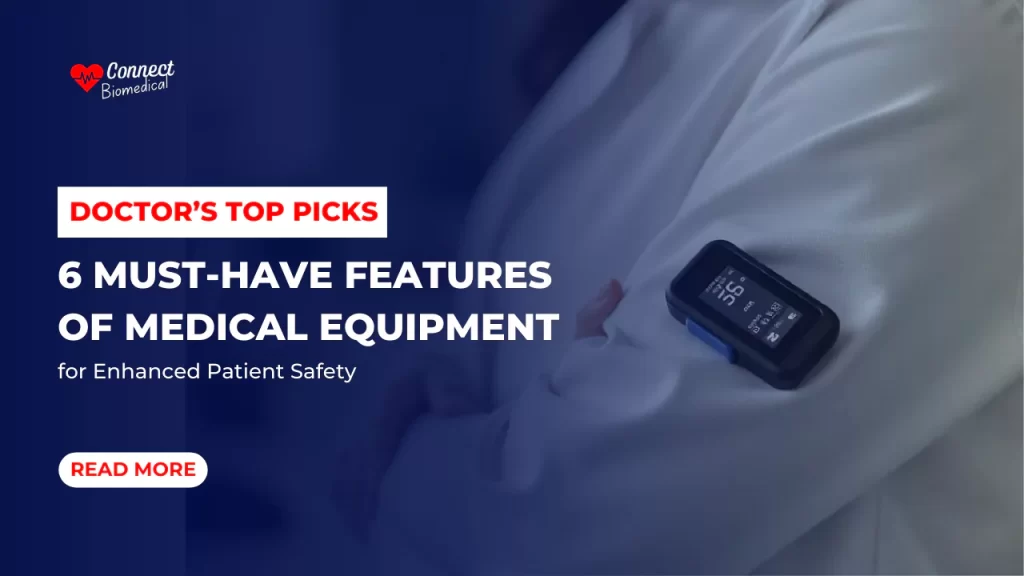In the ever-evolving landscape of healthcare, biomedical equipment stands at the forefront of innovation, driving improvements in patient care, diagnosis, and treatment.
As we look towards 2025, the rapid advancement of biomedical equipment is revolutionizing patient care and diagnostic capabilities in healthcare facilities worldwide.
This comprehensive guide delves into the latest trends, technologies, and market dynamics shaping the future of biomedical equipment, providing healthcare professionals, administrators, and technicians with the knowledge they need to stay ahead in this dynamic field.
Market Overview and Growth Projections
The biomedical equipment sector is experiencing unprecedented growth across various segments, driven by technological advancements and increasing healthcare demands.
Let’s examine the key market projections for 2025 and beyond:
| Market Segment | Current Value (2024) | Projected Value | CAGR/Growth Period |
| Wearable Devices | $42.74B | 25.53% CAGR | 2025-2030 |
| Medical Robotics | $10.1B | $31.3B by 2035 | 2024-2035 |
| Immersive Technologies | $1.4B | $15.1B by 2037 | 2024-2037 |
| 3D Printing | $3.9B | $30.6B by 2035 | 2024-2035 |
| IoMT | $230.69B | 18.2% CAGR | 2025-2030 |
These projections highlight the significant growth potential across various biomedical equipment segments.
The wearable devices market, in particular, is expected to see explosive growth, with a compound annual growth rate (CAGR) of 25.53% from 2025 to 2030.
This surge is largely attributed to the increasing adoption of remote patient monitoring solutions and the integration of advanced sensors in wearable health devices.
The Internet of Medical Things (IoMT) is another area poised for substantial growth, with a projected CAGR of 18.2% from 2025 to 2030.
This growth is driven by the increasing interconnectivity of medical devices and the rising demand for real-time patient data analysis.
Cutting-Edge Biomedical Equipment Technology Shaping Healthcare in 2025
As we approach 2025, cutting-edge biomedical equipment technology integrates AI and machine learning to enhance diagnostic accuracy and treatment outcomes. Let’s explore the key technological trends that are reshaping the biomedical equipment landscape:
1. AI and Machine Learning Integration
Artificial Intelligence (AI) and Machine Learning (ML) are revolutionizing biomedical equipment, enhancing diagnostic capabilities and treatment planning.
The AI in healthcare market is projected to reach $35.5 billion by 2029, growing at a CAGR of 29.9%. This growth is driven by the integration of AI in various biomedical equipment, including:
- Diagnostic imaging systems with AI-powered image analysis
- Smart wearables with predictive health algorithms
- AI-assisted surgical robots for enhanced precision
These AI-powered systems are not only improving diagnostic accuracy but also enabling personalized treatment plans based on vast amounts of patient data.
2. Remote Monitoring Solutions
The evolution of wearable devices and IoMT has paved the way for advanced remote monitoring solutions.
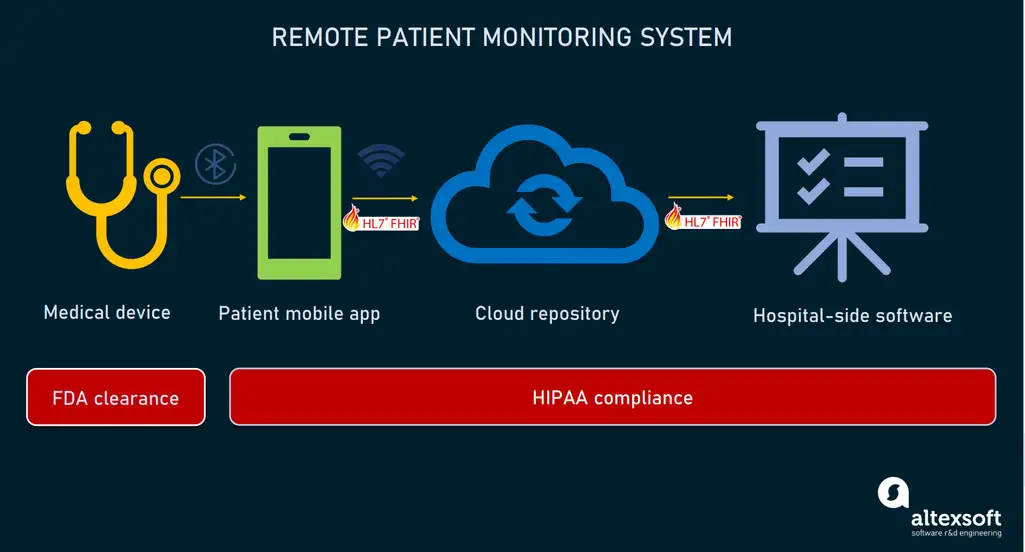
Source:Altexsoft
These technologies are particularly crucial for managing chronic diseases and reducing hospital readmissions. Key developments include:
- Continuous glucose monitors with real-time data transmission
- Smart inhalers for asthma and COPD management
- Wearable ECG monitors for cardiac patients
The integration of 5G technology is further enhancing the capabilities of these remote monitoring devices, enabling faster data transmission and real-time analysis.
3. Cybersecurity Innovations
As biomedical equipment becomes increasingly connected, cybersecurity has become a critical concern. The healthcare cybersecurity market is expected to grow from $13.29 billion in 2024 to $16.71 billion in 2025.
Key cybersecurity innovations in biomedical equipment include:
- Advanced encryption protocols for data transmission
- Blockchain technology for secure patient data management
- AI-powered threat detection systems
These innovations are crucial for protecting patient data and ensuring the integrity of connected medical devices.
Essential Biomedical Equipment Maintenance Practices for Optimal Performance
Regular biomedical equipment maintenance is crucial for ensuring patient safety and extending the lifespan of critical healthcare devices.
As the complexity of medical equipment increases, maintenance practices must evolve to keep pace.
Here are some essential maintenance practices for 2025:
- Predictive Maintenance: Utilizing IoT sensors and AI algorithms to predict equipment failures before they occur.
- Remote Diagnostics: Implementing systems that allow technicians to diagnose and sometimes repair equipment remotely.
- Augmented Reality (AR) Assisted Maintenance: Using AR technology to guide technicians through complex maintenance procedures.
- Automated Documentation: Implementing systems that automatically log maintenance activities and equipment performance data.
By adopting these advanced maintenance practices, healthcare facilities can significantly reduce equipment downtime, extend device lifespan, and ensure optimal performance.
Advanced Biomedical Test Equipment: Ensuring Accuracy and Reliability
State-of-the-art biomedical test equipment plays a vital role in calibrating and verifying the performance of medical devices.
As medical equipment becomes more sophisticated, so too must the tools used to test and calibrate them.
Some of the advanced biomedical test equipment emerging in 2025 include:
- Multi-parameter Simulators: Devices capable of simulating multiple physiological parameters simultaneously for comprehensive equipment testing.
- High-precision Electrical Safety Analyzers: Equipment designed to ensure medical devices meet stringent electrical safety standards.
- Automated Test Systems: Robotic systems that can perform a series of tests on medical equipment with minimal human intervention.
- Portable Calibration Devices: Compact, highly accurate calibration tools that can be easily transported for on-site equipment testing.
These advanced testing tools are essential for maintaining the accuracy and reliability of biomedical equipment, ultimately contributing to improved patient care and safety.
Comprehensive Biomedical Equipment Service Solutions for Healthcare Facilities
Comprehensive biomedical equipment service programs are essential for minimizing downtime and optimizing healthcare operations.
As we move towards 2025, biomedical equipment service is evolving to meet the complex needs of modern healthcare facilities.
Key aspects of these service solutions include:
- Proactive Maintenance Scheduling: Using data analytics to optimize maintenance schedules and prevent unexpected downtime.
- 24/7 Remote Support: Providing round-the-clock remote assistance for troubleshooting and minor repairs.
- Training and Education Programs: Offering ongoing training for hospital staff to ensure proper equipment usage and basic maintenance.
- Asset Management Services: Implementing comprehensive tracking and management systems for all biomedical equipment within a facility.
By adopting these comprehensive service solutions, healthcare facilities can ensure their biomedical equipment remains in optimal condition, reducing costs and improving patient care.
Exploring Biomedical Equipment Technician Jobs: Career Opportunities in 2025
The demand for skilled professionals in biomedical equipment technician jobs is expected to grow significantly as healthcare technology continues to evolve. The role of biomedical equipment technicians is expanding and becoming increasingly specialized.
Here are some key trends in the job market:
- Specialization in AI and Machine Learning: Technicians with expertise in maintaining and troubleshooting AI-powered medical equipment will be in high demand.
- Cybersecurity Skills: As medical devices become more connected, technicians with cybersecurity knowledge will be crucial for protecting patient data and equipment integrity.
- Remote Diagnostics Expertise: Skills in remote troubleshooting and maintenance will be essential as healthcare facilities adopt more remote monitoring solutions.
- Robotics Maintenance: With the growth of surgical and diagnostic robots, technicians specializing in robotic systems maintenance will be sought after.
For those considering a career in this field, obtaining certifications such as the Certified Biomedical Equipment Technician (CBET) credential will be increasingly important for career advancement.
Emerging Technologies Shaping the Future of Biomedical Equipment
Several emerging technologies are poised to revolutionize the biomedical equipment landscape:
Regenerative Medicine and Tissue Engineering
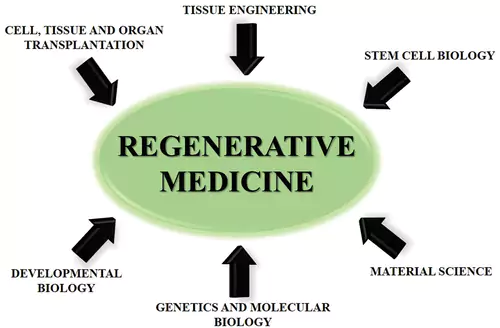
Source: Tandfonline
Advancements in stem cell technology and bioengineered tissues are opening new frontiers in medical treatment.
Key developments include:
- 3D bioprinting of organs and tissues for transplantation
- Smart scaffolds for tissue regeneration
- Gene editing technologies for personalized regenerative therapies
These technologies are not only advancing treatment options but also driving the development of new biomedical equipment for tissue cultivation and transplantation.
Robotics in Surgery
Surgical robotics is rapidly evolving, offering enhanced precision and improved patient outcomes. Future developments in this field include:
- AI-powered surgical assistants capable of real-time decision support
- Miniaturized robotic systems for minimally invasive procedures
- Haptic feedback systems for improved surgeon control and sensation
As these technologies advance, they will require specialized biomedical equipment for maintenance, calibration, and operation.
“Robotic surgery in gynaecology offers unparalleled precision and less invasive options for complex conditions like endometriosis, fibroids, and prolapse. At CK Birla Hospital, Gurugram, we utilize the advanced da Vinci system, ensuring the best possible outcomes with a patient-centered approach.”
– Dr Astha Dayal (Obs and Gyne) in Gurgaon
Future Outlook and Conclusion
As we approach 2025, the biomedical equipment industry stands on the cusp of a technological revolution. The integration of AI, IoT, and advanced materials science is pushing the boundaries of what’s possible in healthcare.
From AI-powered diagnostic tools to regenerative medicine technologies, the future of biomedical equipment promises to transform patient care and treatment outcomes.
For healthcare professionals, administrators, and technicians, staying informed about these advancements is crucial.
The rapid pace of innovation in biomedical equipment will require ongoing education and adaptation to new technologies.
However, with these challenges come immense opportunities to improve patient care, streamline healthcare operations, and push the boundaries of medical science.
As we navigate this exciting future, one thing is clear: the field of biomedical equipment will continue to be at the forefront of healthcare innovation, driving improvements in diagnosis, treatment, and patient outcomes for years to come.

